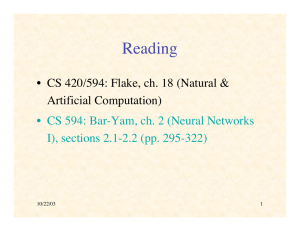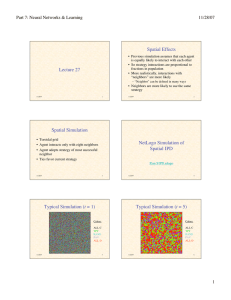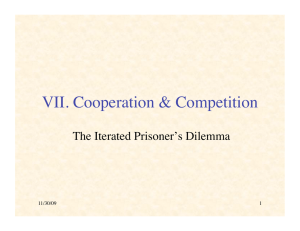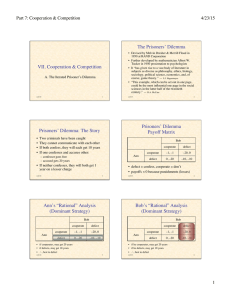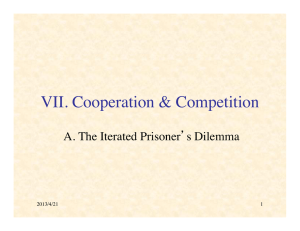Reading Ecological & Spatial Models Ecological Model Variables
advertisement
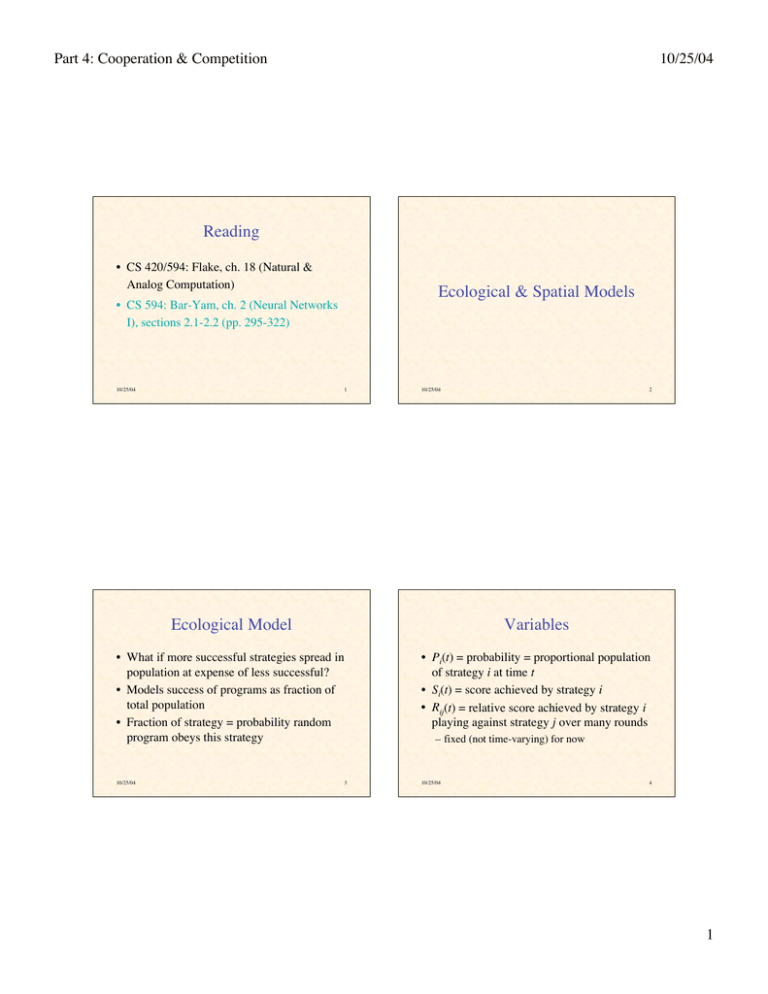
Part 4: Cooperation & Competition 10/25/04 Reading • CS 420/594: Flake, ch. 18 (Natural & Analog Computation) Ecological & Spatial Models • CS 594: Bar-Yam, ch. 2 (Neural Networks I), sections 2.1-2.2 (pp. 295-322) 10/25/04 1 10/25/04 2 Ecological Model Variables • What if more successful strategies spread in population at expense of less successful? • Models success of programs as fraction of total population • Fraction of strategy = probability random program obeys this strategy • Pi(t) = probability = proportional population of strategy i at time t • Si(t) = score achieved by strategy i • Rij(t) = relative score achieved by strategy i playing against strategy j over many rounds 10/25/04 10/25/04 3 – fixed (not time-varying) for now 4 1 Part 4: Cooperation & Competition 10/25/04 Computing Score of a Strategy Updating Proportional Population • Let n = number of strategies in ecosystem • Compute score achieved by strategy i: Pi ( t + 1) = n Si ( t ) = Rik ( t ) Pk ( t ) k=1 Pi (t ) Si (t ) n j=1 P j (t ) S j (t ) S( t ) = R(t )P(t ) 10/25/04 5 10/25/04 Demonstration Simulation Some Simulations • 60% ALL-C • 20% RAND • 10% ALL-D, TFT • Usual Axelrod payoff matrix • 200 rounds per step 10/25/04 6 7 10/25/04 8 2 Part 4: Cooperation & Competition 10/25/04 Collectively Stable Strategy “Win-Stay, Lose-Shift” Strategy • Let w = probability of future interactions • Suppose cooperation based on reciprocity has been established • Then no one can do better than TFT provided: • Win-stay, lose-shift strategy: – begin cooperating – if other cooperates, continue current behavior – if other defects, switch to opposite behavior T R T R w max , R S T P • Called PAV (because suggests Pavlovian learning) • The TFT users are in a Nash equilibrium 10/25/04 9 10/25/04 Simulation without Noise 10 Effects of Noise • 20% each • no noise • Consider effects of noise or other sources of error in response • TFT: – cycle of alternating defections (CD, DC) – broken only by another error • PAV: – eventually self-corrects (CD, DC, DD, CC) – can exploit ALL-C in noisy environment • Noise added into computation of Rij(t) 10/25/04 11 10/25/04 12 3 Part 4: Cooperation & Competition 10/25/04 Simulation with Noise Spatial Effects • 20% each • 0.5% noise • Previous simulation assumes that each agent is equally likely to interact with each other • So strategy interactions are proportional to fractions in population • More realistically, interactions with “neighbors” are more likely – “Neighbor” can be defined in many ways • Neighbors are more likely to use the same strategy 10/25/04 13 10/25/04 Typical Simulation (t = 1) Spatial Simulation • Toroidal grid • Agent interacts only with eight neighbors • Agent adopts strategy of most successful neighbor • Ties favor current strategy 10/25/04 14 Colors: ALL-C TFT RAND PAV ALL-D 15 10/25/04 16 4 Part 4: Cooperation & Competition 10/25/04 Typical Simulation (t = 5) Typical Simulation (t = 10) Colors: Colors: ALL-C TFT RAND PAV ALL-D ALL-C TFT RAND PAV ALL-D 10/25/04 17 10/25/04 Typical Simulation (t = 10) Zooming In 18 Typical Simulation (t = 20) Colors: ALL-C TFT RAND PAV ALL-D 10/25/04 19 10/25/04 20 5 Part 4: Cooperation & Competition 10/25/04 Typical Simulation (t = 50) Zoom In Typical Simulation (t = 50) Colors: ALL-C TFT RAND PAV ALL-D 10/25/04 21 10/25/04 22 SIPD Without Noise Simulation of Spatial Iterated Prisoners Dilemma Run sipd simulator 10/25/04 23 10/25/04 24 6 Part 4: Cooperation & Competition 10/25/04 Additional Bibliography Conclusions: Spatial IPD 1. • Small clusters of cooperators can exist in hostile environment • Parasitic agents can exist only in limited numbers • Stability of cooperation depends on expectation of future interaction • Adaptive cooperation/defection beats unilateral cooperation or defection 10/25/04 2. 3. 4. 5. 25 von Neumann, J., & Morgenstern, O. Theory of Games and Economic Behavior, Princeton, 1944. Morgenstern, O. “Game Theory,” in Dictionary of the History of Ideas, Charles Scribners, 1973, vol. 2, pp. 263-75. Axelrod, R. The Evolution of Cooperation. Basic Books, 1984. Axelrod, R., & Dion, D. “The Further Evolution of Cooperation,” Science 242 (1988): 1385-90. Poundstone, W. Prisoner’s Dilemma. Doubleday, 1992. 10/25/04 26 7
